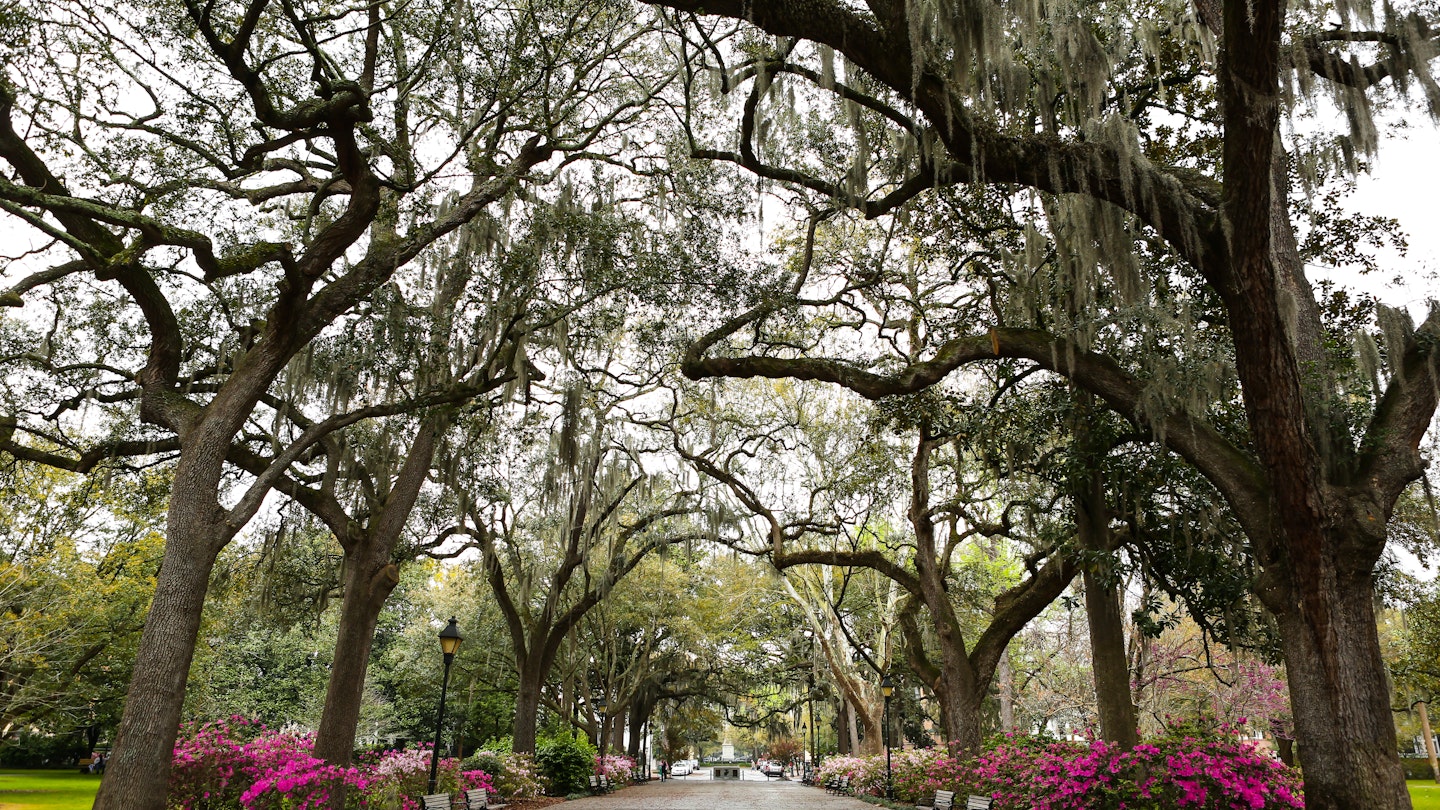
Centuries-old statues, maritime forests brimming with wildlife, and giant oak trees offer shade from the hot sun. Savannah’s city parks are ideal for both quiet moments and adventurous outings. Whether you crave history, outdoor recreation, or simply beautiful vistas, you’ll find them at these parks.

Forsyth Park
Best park for people watching
Forsyth Park covers 30 acres in the heart of the city and is one of Savannah’s largest inner-city parks—think of it as the city’s answer to NYC’s Central Park. Locals and visitors love Forsyth’s relaxed atmosphere. On the north end of the park, you can pose for a picture at the 150-year old Forsyth statue.
This park is perfect for a picnic under the trees. The southern end is designed for active types, featuring basketball and tennis courts. Additionally, you can explore the Farmers’ Markets on Sundays, attend concerts, soak up sunlight, or play soccer.
With Savannah’s open-cup policy, if you’re planning an outing with friends, consider grabbing a bottle of wine. There are also excellent restaurants and charming bed and breakfasts just steps away from the park, such as The Collins Quarter, Kitchen 320, a.Lure, B. Matthews, and The Mansion on Forsyth.

Skidaway Island State Park
Best park to get away from it all
Explore Georgia’s maritime forests, salt marshlands, and intracoastal waterways at the 588-acre Skidaway Island State Park, located about 15 miles south of Savannah on Georgia’s Intracoastal Waterway. The Skidaway Wildlife Management Area offers pristine views, picturesque trails, and camping in an unspoiled habitat. Wildlife here includes deer, fiddler crabs, reptiles, egrets, and migrating birds. Visitors can enjoy a panoramic view of the island from the observation tower and interpretive center.

Oatland Island
Best park for animal lovers
The Oatland Island Wildlife Center combines education, beauty, and nature trails in one location. Located about 10 minutes from Savannah, the park offers an unforgettable outdoor experience for visitors of all ages, marrying the intimacy of a zoo with the wild allure of nature.
Encounter bald eagles, cougars, falcons, bobcats, red foxes, bison, and alligators along the two-mile hike through marshes and maritime forests. Children are especially enchanted as they can walk through the farm area and view wolves up close at the Wolf Wilderness exhibit. In addition, the park features a 185,000-sq-ft educational building with over 150 animals including pigs, ducks, sheep, and cows.

Tricentennial Park
Best park for history buffs
Tricentennial Park, located in downtown Savannah and near hotels like the Alida and the Tryp, is a must-see for history enthusiasts. As its name suggests, the 25-acre park encompasses three centuries of history. History lovers will enjoy exploring the Battlefield Memorial Park, which pays tribute to the soldiers involved in the third bloodiest battle of the American Revolution—the Battle for Savannah.
Within the park, you can find three museums: Savannah History Museum, Georgia State Railroad Museum, and Savannah Children’s Museum. The first museum is housed in a historic train shed, while the railroad and children’s museums are outdoors.
Children can expend their energy exploring the outdoor areas and later the entire family can take a ride on the antique train. If you enjoy learning about history and have young ones who want to play outside, consider spending an afternoon here.

Daffin Park
Best park for architecture enthusiasts
Daffin Park, designed by John Nolen in 1907, covers 80 acres on Savannah’s east side off Victory Drive. Featuring two circular nodes and diagonal streets lined with tree trunks, this park boasts a formal Beaux-Arts style.
Daffin Park features a picturesque lake, two miles of paved eight-foot-wide sidewalks that are handicap-accessible, and a shorter (1/3 mile) walkway that circles the lake. Additionally, the park includes athletic fields, tennis courts, a volleyball court, a swimming pool, picnic areas, a pavilion, and a playground. Daffin is the city’s largest recreational park and allows pets.
Lake Mayer Park
Best park for fitness fans
Located on 75 acres and about 15 minutes from Savannah, Lake Mayer Park features a freshwater lake, a jogging and cycling track, along with 18 fitness stations and a 1.7-mile trail loop.
This complex also includes a baseball and softball field, tennis courts, basketball courts, volleyball courts, handball courts, and a dog exercise area. Two pavilions are available for rent, complemented by ample parking and restrooms. A fishing pier and a boat ramp lead to the well-stocked lake where visitors can hope to catch bass, catfish, and perch.

Chippewa Square
Best park for art lovers
One of Savannah’s 22 squares, Chippewa Square is located in the city’s historic district and is a wonderful place to sit under shady live oaks. These squares are relatively small, measuring around 200 x 200 ft.
Part of the 1994 movie, Forrest Gump, was filmed in this famous square. Most will recognize the scene where Tom Hanks sat at the bus stop, marked by a sign for reference.
Art aficionados should explore local art at Gallery Espresso and Roots Up Gallery to support the thriving local art scene. Additionally, the Savannah Art Association Gallery showcases many local artists working in various mediums, including pottery and folk art.
Architecture enthusiasts will appreciate the Philbrick-Eastman House, a stunning Greek revival-style home dating back to 1847, featuring grand columns and a fence adorned with medallions of prominent Savannah historical figures.

Wormsloe Historic Site
Best place for photographers
Wormsloe, located 15 minutes from Savannah’s historic district, is one of the city’s oldest estates, dating back to the 1700s. The site is surrounded by giant oaks and Spanish moss, offering a picturesque view of the oldest standing structure in Savannah—Wormsloe Village—as you stroll through this timeless environment.
During the period from the 1500s to the 1800s, Tabby, a substance composed of shells, sand, and lime, was commonly used to build houses in the southeast, which can be observed here. Visitors can also take a tour of a museum dedicated to Wormsloe’s rich history. Consequently, Wormsloe’s stunning scenery and historical significance provide an engaging experience for all ages.





